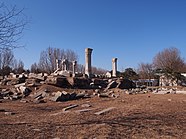
Back حديقة يوانمينغيوان Arabic Jardins de la Perfecta Lluentor Catalan Yuanmingyuan CEB Starý letní palác Czech Det gamle kejserlige sommerpalads Danish Yu Yuan (Peking) German Yuan Ming Yuan-Imperia Ĝardeno Esperanto Antiguo Palacio de Verano Spanish Ancien Palais d'Été French Istana Musim Panas Lama ID
| Old Summer Palace | |||||||
|---|---|---|---|---|---|---|---|
| Simplified Chinese | 圆明园 | ||||||
| Traditional Chinese | 圓明園 | ||||||
| Literal meaning | Gardens of Perfect Brightness | ||||||
| |||||||
| Imperial Gardens | |||||||
| Simplified Chinese | 御园 | ||||||
| Traditional Chinese | 御園 | ||||||
| |||||||
The Old Summer Palace, also known as Yuanmingyuan (traditional Chinese: 圓明園; simplified Chinese: 圆明园; pinyin: Yuánmíng Yuán; lit. 'Gardens of Perfect Brightness') or Yuanmingyuan Park,[1] originally called the Imperial Gardens (traditional Chinese: 御園; simplified Chinese: 御园; pinyin: Yù Yuán), and sometimes called the Winter Palace,[2][3] was a complex of palaces and gardens in present-day Haidian District, Beijing, China. It is 8 kilometres (5 mi) north-west of the walls of the former Imperial City section of Beijing. Widely perceived as the pinnacle work of Chinese imperial garden and palace design, the Old Summer Palace was known for its extensive collection of gardens, its building architecture and numerous art and historical treasures. Constructed throughout the 18th and early 19th centuries, the Old Summer Palace was the main imperial residence of Qianlong Emperor of the Qing dynasty and his successors, and where they handled state affairs; the Forbidden City was used for formal ceremonies. The Garden was reputed as the "Garden of Gardens" (simplified Chinese: 万园之园; traditional Chinese: 萬園之園; pinyin: wàn yuán zhī yuán) in its heyday was "arguably the greatest concentration of historic treasures in the world, dating and representing a full 5,000 years of an ancient civilization", according to Robert McGee, chaplain to the British forces.
During the Second Opium War, French and British troops captured the palace on 6 October 1860, looting and destroying the imperial collections over the next few days.[4][5] As news emerged that an Anglo-French delegation had been imprisoned and tortured by the Qing government, with 19 delegation members being killed,[6] the British High Commissioner to China, James Bruce, 8th Earl of Elgin, retaliated by ordering the complete destruction of the palace on 18 October, which was then carried out by troops under his command.[5] The palace was so large – covering more than 3.5 square kilometres (860 acres) – that it took 4,000 men three days to destroy it.[7] Many exquisite artworks – sculptures, porcelain, jade, silk robes, elaborate textiles, gold objects and more – were looted and, according to UNESCO, are now located in 47 museums around the world.[8]
- ^ "Yuanmingyuan Park official website". yuanmingyuanpark.cn. Archived from the original on 2021-05-08.
- ^ ZHANG Ming-jian (2007). Impact of English on Chinese mainland: From historical, educational and political dimensions (PDF). US-China Education Review. p. 62. Retrieved 13 January 2021.
- ^ "Dagu Fort". Top China Travel. Retrieved 13 January 2021.
- ^ Ringmar 2013, p. 6.
- ^ a b Bowlby, Chris (2 February 2015). "The palace of shame that makes China angry". BBC News. Retrieved 28 February 2015.
- ^ Hevia 2003, p. 47.
- ^ "The loot from China's old Summer Palace in Beijing that still rankles | Oxford Today". www.oxfordtoday.ox.ac.uk. Archived from the original on 2018-04-17. Retrieved 2018-06-30.
- ^ 张行健. "Old Summer Palace marks 157th anniversary of massive loot". www.chinadaily.com.cn. Retrieved 2018-06-30.
© MMXXIII Rich X Search. We shall prevail. All rights reserved. Rich X Search







